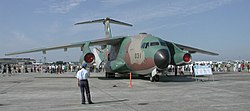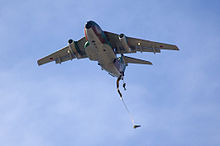Kawasaki C-1
| Kawasaki C-1 | |
|---|---|

|
|
| Type: | Transport plane |
| Design country: | |
| Manufacturer: | |
| First flight: |
1970 |
| Commissioning: |
1973 |
| Number of pieces: |
31 |
The Kawasaki C-1 is a twin-engine short-range transport aircraft produced by the Japanese manufacturer Kawasaki . The aircraft, built in 31 copies, had its first flight in 1970 and is used exclusively by the Japanese air self-defense forces.
history
The two prototypes took off on their first flights on November 12, 1970 and January 16, 1971, respectively. In 1973 two pre-series machines were delivered to the Japanese Self-Defense Forces.
The machines of the C-1A series were intended to replace the outdated Curtiss C-46 Commando of the Japanese Air Self-Defense Forces.
For ECM training, Kawasaki modified the 21st series machine to the EC-1 . It flew for the first time on December 3, 1984 and was recognizable by large radomes on the underside of the stern and on the bow.
From 2001, the successor Kawasaki C-2 was developed at Kawasaki , which had its maiden flight on January 26, 2010 and is now to gradually replace this type of aircraft.
construction
With the Kawasaki C-1, the Kawasaki Heavy Industries group created the first Japanese transport aircraft with jet engines . The fuselage is similar to the later American Boeing C-17 . It has a large loading ramp in the rear for loading. The two jet engines are housed in gondolas on the swept wings of the shoulder wing. The main landing gear, which can be retracted into the lateral fuselage bulges, is designed as a four-wheeled carriage landing gear on each side, the nose landing gear has double tires.
Modifications
Based on the C-1, the National Aerospace Laboratory (NAL) built the experimental STOL Asuka aircraft . Four FJR710 turbofans with a high bypass flow ratio were installed as engines .
use
The Japanese air self-defense forces are the only users of the machine, which was built for military purposes anyway.
There it is used primarily for the transport of equipment and airborne units, which are unloaded at the destination at an airfield or airport or - in the absence of such a possibility - are dropped off by parachute.
Incidents
From the first flight in 1970 to November 2017, the Kawasaki C-1 suffered four total write-offs of aircraft. 19 people were killed in 3 of them.
Technical specifications
| Parameter | Data |
|---|---|
| Year of construction (s) | 1970-1979 |
| Manufacturer | Kawasaki Heavy Industries Ltd. |
| Type | Medium-haul vans |
| Engines | 2 × Turbofans Pratt & Whitney JT8D -9 |
| power | 2 × 64.5 kN |
| span | 30.60 m |
| length | 29.00 m |
| height | 10.00 m |
| Wing area | 120.5 m² |
| payload | 11,900 kg |
| Max. Takeoff weight | 45,000 kg |
| crew | 5 people |
| Cruising speed | 685 km / h at 10,700 m |
| Top speed | 787 km / h at 7600 m |
| Service ceiling | 12,000 m |
| Max. Range | 3335 km with 8000 kg payload |
See also
Web links
Individual evidence
- ↑ Accident statistics Kawasaki C-1 , Aviation Safety Network (English), accessed on December 17, 2017.

